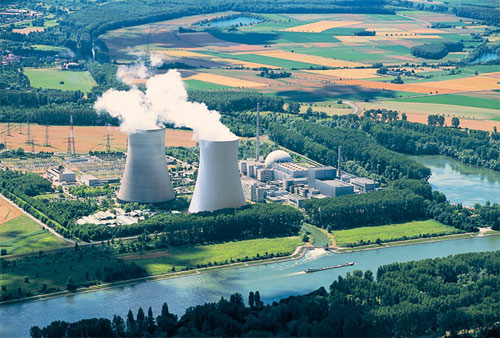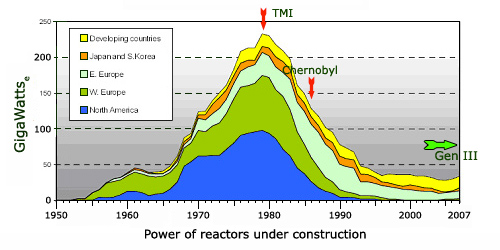1970-2009: the rise of nuclear energy

Boiling and pressurized water reactors
The Philippsburg nuclear power plant in Germany gather on the same site two reactors belonging to the two main main families of second-generation reactors: pressurized water and boiling water reactors. They both burn enriched uranium nuclear fuel. They use ordinary water – pressurized or boiling – to cool down the reactor core converting the heat into electricity and to slow the neutrons to sustain the fission reaction. In 2008, the 17 reactors operating in Germany produced 148.8 billion kilowatt hours … without CO2.
@ ENBW
About 85% of electricity produced worldwide by nuclear power comes from “second-generation” reactors, heirs to the 1950-1960s prototypes. They make up the vast majority of some 439 units deployed today. In 2008 they supplied a total electric power of 372 GWe. These reactors are located in 30 countries (93% of Generation II and 7% of Generation I), accumulating altogether an experience of more than 13,600 reactor-years.
The deployment of civilian nuclear power took off after the 1974 oil crisis. In particular France had to ensure energy independence within a volatile global political context. This rise was slowed by the Three Mile Island accident in 1978 and much more by the one at Chernobyl in 1986. The Three Mile Island accident was at the origin of the Carter Doctrine with the halting of the construction of nuclear plants in the USA. On the positive side, it has also led to many improvements that benefited the safety of nuclear installations.
Second-generation reactors belong to main two families of light water reactors (LWR): Pressurized Water Reactors or PWR and Boiling Water Reactors or BWR. Both use enriched uranium as nuclear fuel and neutrons moderated with water. Water is used also for cooling. Through a heat exchanger, steam is generated, activating turbines and producing electricity. In the late 1960s, uranium enrichment became available for civilian purposes and was no longer reserved solely for defence. This fact allowed the generalized use of light water for reactors,
France had built at Tricastin in the Rhone Valley a large uranium enrichment facility, based on gaseous diffusion but now replaced by ultracentrifugation. President Georges Pompidou, in October 1969, took the decision to abandon the national French first-generation gas-graphite reactors in favour of the most promising U.S PWR burning enriched uranium. Those who thought that France was losing its independence criticized the decision at the time. A specialized company Framatome was established to build new reactors. A license for pressurized water reactors of was bought to the US company Westinghouse, but in 1982 after paying the license several years, Framatome, with the help of the CEA developed a purely French technology.
The standardization of French reactors contributes to their success. Ivan Stelin, president of the U.S. regulator once said “The French have 100 different cheeses and one plant model. We have the opposite! ”

Construction peak in the 1980s.
Most of second-generation reactors have been built in developed countries, such as USA, EU, Japan and South Korea. The construction of nuclear power plant (the construction of a reactor is spread over several years) reached a maximum around the year 1980. The decline thereafter is due in the U.S.to the aftermath of the Three Mile Island accident (Carter Doctrine) and in France by the fact that the nuclear park has met the energy demand. After 2000, major Asian countries like China, India begin to equip themselves with the beginning of a third generation of reactors.
@ P.Reuss / EDP-Sciences
The uranium fuel of second-generation reactors is enriched from 3.5 to 5% in fissile uranium 235. The enrichment level offer the advantage to allow the use of ordinary water to slow down the neutrons, a slowing required for the operation of the reactors when the proportion of fissionable material is low. The fuel in the form of pellets of uranium oxide UO2 is encapsulated inside long rods of zirconium. This metal is transparent to neutrons, and replaced stainless steel. In some reactors, the nuclear fuel, includes up to 1/3 of MOX a mixed oxide of uranium and plutonium containing around 6% of fissile plutonium.
The United Kingdom has developed its own AGR (advanced gas-cooled reactor) reactors. AGR are graphite-moderated reactors operating with slightly enriched uranium, following the original Magnox reactors. Canada has improved their natural uranium CANDU reactors, and sold them in Argentina, China, India, Romania and Korea. The Soviet Union developed the RBMK reactors, involved in the Chernobyl accident, followed by the VVER pressurized water reactor, similar to the PWR.
In 2008, more than 550 plants have been built worldwide, including more than 110 that have been shut down. Their average age was over 20 years while 50 reactors were over 30 years and 9 over 40 years, and shut-downs were foreseen to peak after 2015. Performance improves. Today, the same amount of nuclear fuel produces twice the energy than 20 years ago. A good availability in terms of safety and reliability, the ability to expand the reactors life to 50 years, have renewed the electricians confidence in nuclear power utilities. Particularly in the USA, more than half of the 104 reactors have already received permission for life-extension from the U.S. regulator commission, the NRC. U.S. is also planning for new reactors.
ALSO : First Generation Reactors
Other articles on the subject « Nuclear Reactors »
Reactor Families
A variety of designs : Natural uranium or enriched uranium as fuel There are several industrial t[...]
World nuclear reactors
A development that takes place today in Asia At the beginning of 2014 the number of reactors in o[...]
Generation I reactors
1950-1970: First generation of reactors (50 – 500 MWe) The first generation reactors were i[...]
RBMK reactors
Soviet-era reactors at Chernobyl Cold War and the Iron Curtain led after 1947 to the development [...]
PWR Reactors
The most widespread type of reactor … Pressurised water reactors (PWR) are by far the most [...]
PWR Operation
High pressure water to evacuate heat and slow down neutrons The reactor core is the source of ene[...]
Boiling Water Reactors
BWR or Boiling Water Reactors Boiling water reactors or BWR are in operation in the United States[...]
Candu reactors
Canadian reactors using natural uranium and heavy water CANDU is a nuclear reactor brand develope[...]
Nuclear Propulsion
On-board reactors for submarines and aircraft carriers In addition to conventional land-based pow[...]